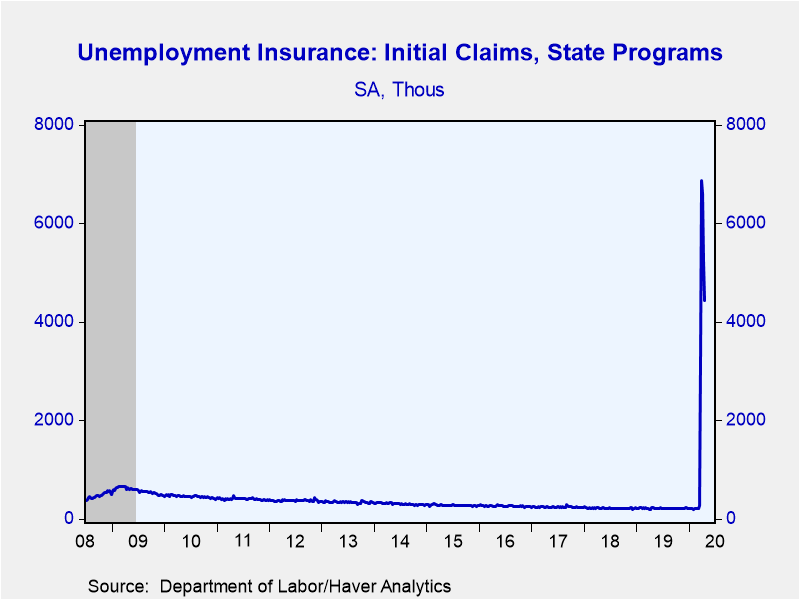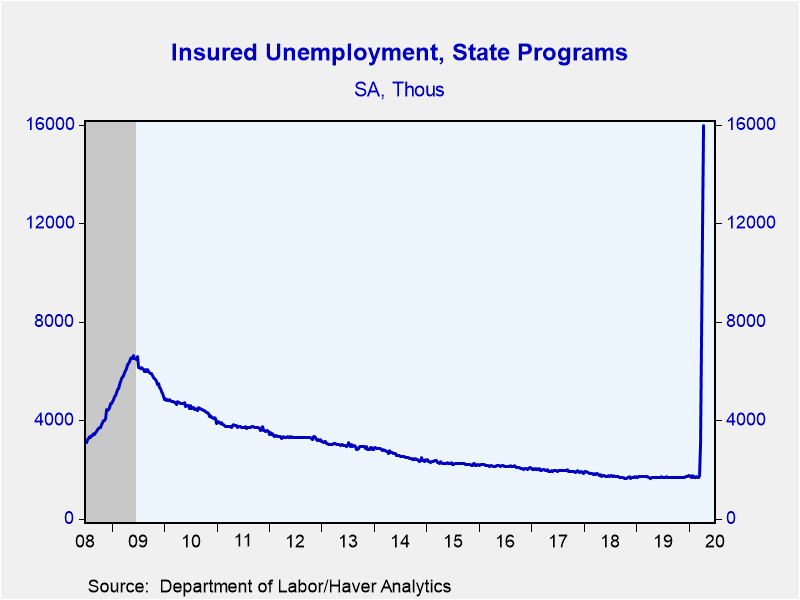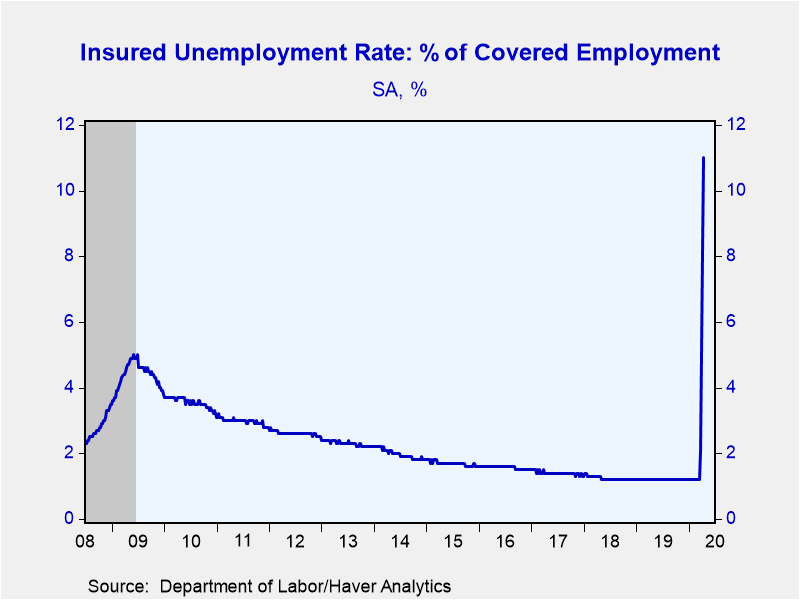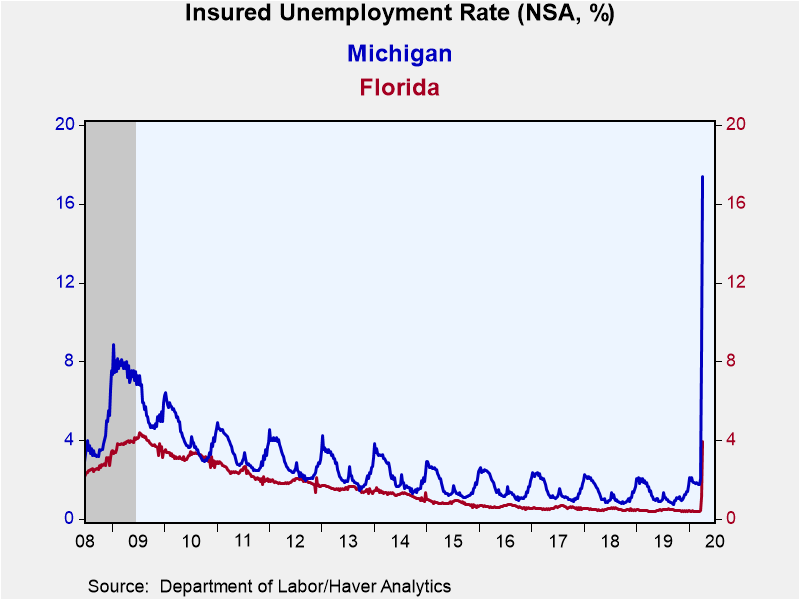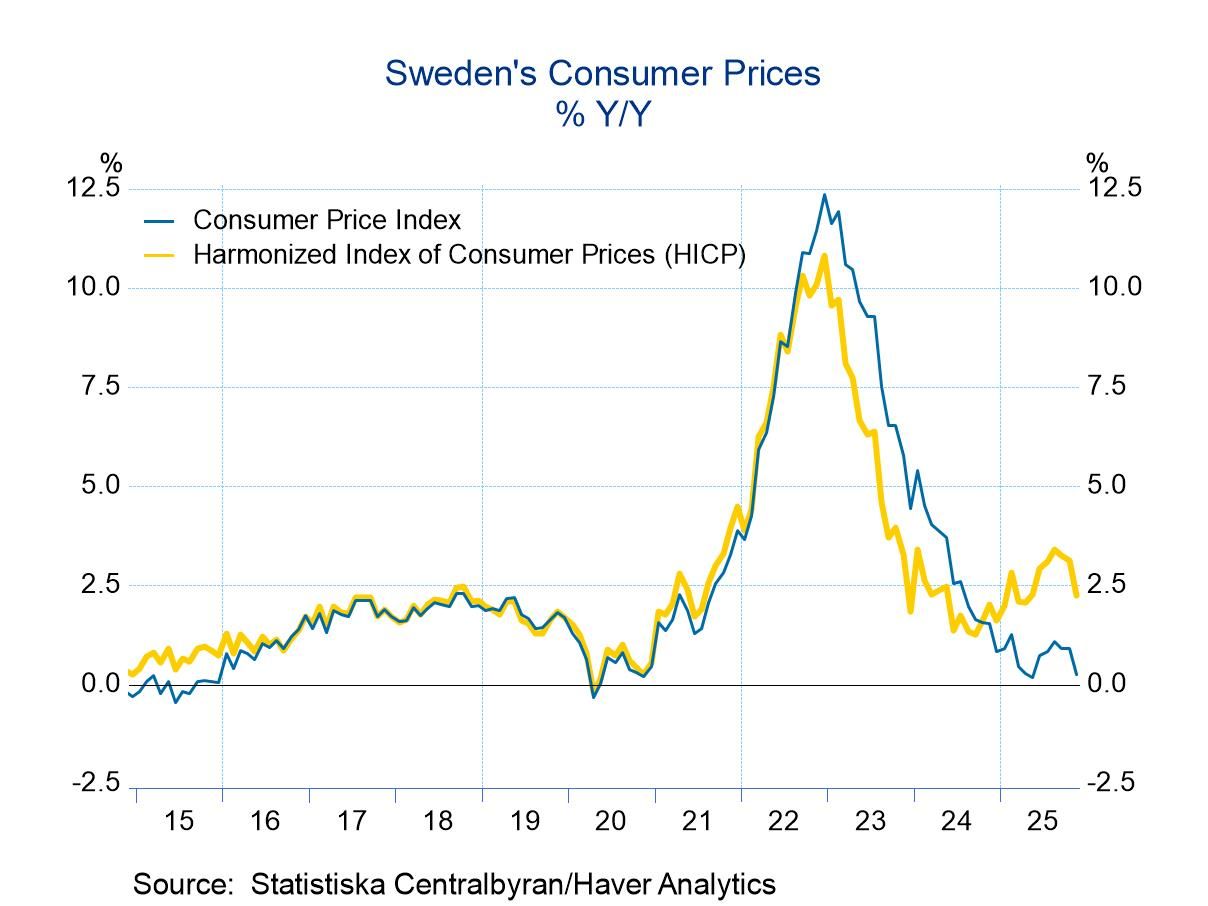 Global| Apr 23 2020
Global| Apr 23 2020U.S. Claims for Unemployment Insurance Slip, but Remain Historically High
by:Tom Moeller
|in:Economy in Brief
Summary
• Initial claims for jobless insurance eased to 4.427 million last week. • Roughly 26 million individuals filed new claims during the last five weeks. • The insured jobless rate jumped to 11.0%. Initial jobless claims for unemployment [...]
• Initial claims for jobless insurance eased to 4.427 million last week.
• Roughly 26 million individuals filed new claims during the last five weeks.
• The insured jobless rate jumped to 11.0%.
Initial jobless claims for unemployment insurance fell to 4.427 million during the week ended April 18 from 5.237 million in the prior week, revised from 5.245 million. During the last five weeks, 26.453 million people (16.2% of the labor force) filed new claims. The Action Economics Forecast Survey anticipated 4.200 million new filings. The four-week moving average of initial claims of 5.787 million compares to 233,000 early in March.
The latest initial claims figure covered the survey period for April nonfarm payrolls. Claims have increased nearly sixteen times since the March survey week. During the last 20 years, there has been a 70% correlation between the level of initial claims an the m/m change in nonfarm payrolls.
Continuing claims for unemployment insurance increased to a record 15.976 million (863.0% y/y) in the week ending April 11 from 11.912 million one week earlier, revised from 11.976 million. The four-week moving average of claimants increased to 9.598 million from 6.050 million. The level rose from 1.726 million four weeks earlier. The insured rate of unemployment rose to 11.0% from 8.2%.
The state insured rates of unemployment are lagged by two weeks. The new data cover the week ended April 4. The highest rates were in Michigan (17.4%) and Rhode Island (15.0%), followed by Pennsylvania at 10.6%. The lowest rates were in Florida at 4.0% and South Dakota at 3.5%. These figures increased sharply in the latest week. In other states, New York realized 11.9% unemployment, New Jersey was 10.7%, California stood at 8.3% and Texas was 5.1%. These data are not seasonally adjusted.
Data on weekly unemployment claims going back to 1967 are contained in Haver's WEEKLY database, and they are summarized monthly in USECON. Data for individual states are in REGIONW. The expectations figure is from the Action Economics Forecast Survey, carried in the AS1REPNA database.
| Unemployment Insurance (SA, 000s) | 04/18/20 | 04/11/20 | 04/04/20 | Y/Y % | 2019 | 2018 | 2017 |
|---|---|---|---|---|---|---|---|
| Initial Claims | 4,427 | 5,237 | 6,615 | 1,858.8 | 218 | 221 | 244 |
| 4-wk Average | 5,787 | 5,507 | 4,268 | -- | -- | -- | -- |
| Continuing Claims | -- | 15,976 | 11,912 | 863.0 | 1,701 | 1,756 | 1,961 |
| 4-week Average | -- | 9,598 | 6,050 | -- | -- | -- | -- |
| Insured Unemployment Rate (%) | -- | 11.0% | 8.2 |
1.2 |
1.2 | 1.2 | 1.4 |
Tom Moeller
AuthorMore in Author Profile »Prior to joining Haver Analytics in 2000, Mr. Moeller worked as the Economist at Chancellor Capital Management from 1985 to 1999. There, he developed comprehensive economic forecasts and interpreted economic data for equity and fixed income portfolio managers. Also at Chancellor, Mr. Moeller worked as an equity analyst and was responsible for researching and rating companies in the economically sensitive automobile and housing industries for investment in Chancellor’s equity portfolio. Prior to joining Chancellor, Mr. Moeller was an Economist at Citibank from 1979 to 1984. He also analyzed pricing behavior in the metals industry for the Council on Wage and Price Stability in Washington, D.C. In 1999, Mr. Moeller received the award for most accurate forecast from the Forecasters' Club of New York. From 1990 to 1992 he was President of the New York Association for Business Economists. Mr. Moeller earned an M.B.A. in Finance from Fordham University, where he graduated in 1987. He holds a Bachelor of Arts in Economics from George Washington University.


